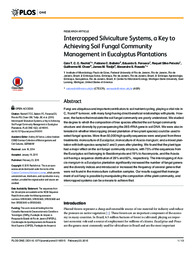Intercropped silviculture systems, a key to achieving soil fungal community management in eucalyptus plantations.
Intercropped silviculture systems, a key to achieving soil fungal community management in eucalyptus plantations.
Author(s): RACHID, C. T. C. C.; BALIEIRO, F. C.; FONSECA, E. S.; PEIXOTO, R. S.; CHAER, G. M.; TIEDJE, J. M.; ROSADO, A. S.
Summary: Fungi are ubiquitous and important contributors to soil nutrient cycling, playing a vital role in C, N and P turnover, with many fungi having direct beneficial relationships with plants. However, the factors that modulate the soil fungal community are poorly understood. We studied the degree to which the composition of tree species affected the soil fungal community structure and diversity by pyrosequencing the 28S rRNA gene in soil DNA. We were also interested in whether intercropping (mixed plantation of two plant species) could be used to select fungal species. More than 50,000 high quality sequences were analyzed from three treatments: monoculture of Eucalyptus; monoculture of Acacia mangium; and a mixed plantation with both species sampled 2 and 3 years after planting. We found that the plant type had a major effect on the soil fungal community structure, with 75% of the sequences from the Eucalyptus soil belonging to Basidiomycota and 19% to Ascomycota, and the Acacia soil having a sequence distribution of 28% and 62%, respectively. The intercropping of Acacia mangium in a Eucalyptus plantation significantly increased the number of fungal genera and the diversity indices and introduced or increased the frequency of several genera that were not found in the monoculture cultivation samples. Our results suggest that management of soil fungi is possible by manipulating the composition of the plant community, and intercropped systems can be a means to achieve that.
Publication year: 2015
Types of publication: Journal article
Unit: Embrapa Soils
Keywords: Eucalipto, Silvicultura
Observation
Some of Embrapa's publications are published as ePub files. To read them, use or download one of the following free software options to your computer or mobile device. Android: Google Play Books; IOS: iBooks; Windows and Linux: Calibre.
Access other publications
Access the Agricultural Research Database (BDPA) to consult Embrapa's full library collection and records.
Visit Embrapa Bookstore to purchase books and other publications sold by Embrapa.

